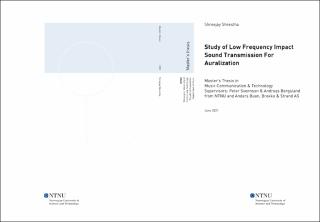Study of Low Frequency Impact Sound Transmission For Auralization
| dc.contributor.advisor | Svennson, Peter | |
| dc.contributor.advisor | Bergsland, Andreas | |
| dc.contributor.advisor | Buen, Anders | |
| dc.contributor.author | Shrestha, Shreejay | |
| dc.date.accessioned | 2022-02-01T18:21:03Z | |
| dc.date.available | 2022-02-01T18:21:03Z | |
| dc.date.issued | 2021 | |
| dc.identifier | no.ntnu:inspera:81412172:44863304 | |
| dc.identifier.uri | https://hdl.handle.net/11250/2976423 | |
| dc.description.abstract | ||
| dc.description.abstract | Footfall induced noise in buildings is traditionally assessed with Impact Sound Transmission (IST) measurements following diffuse field model of the receiving room which is not valid below Schroeder frequency neither it facilitates auralization. This master thesis aims to create a method to estimate low frequency (LF) sound pressure in the receiving room below Schroeder frequency based on modal sum theory in room acoustics followed by measurement of IST, impulse response of the receiving room and acceleration of the main floor at two fixed position in two vertically adjacent laboratories. The study also aims to create monoaural auralization of the sound pressure with a hypothesis that the impulse response of the combined system of floor and receiving room can be used to synthesize the acoustic sound pressure at listening positions in the receiving room. The method to create the LF sound pressure in the receiving room was found to be working to some degree with the main floor showing comparatively higher modal density. More accurate results can be achieved by measuring acceleration of the floor at multiple points. Similarly, the auralization method worked between 20-200Hz with some errors and more accurate results can be accomplished by measuring force signals at higher sampling rate and a more precise calculation of impulse response of the coupled system. | |
| dc.language | eng | |
| dc.publisher | NTNU | |
| dc.title | Study of Low Frequency Impact Sound Transmission For Auralization | |
| dc.type | Master thesis |
Tilhørende fil(er)
Denne innførselen finnes i følgende samling(er)
-
Institutt for musikk [473]
